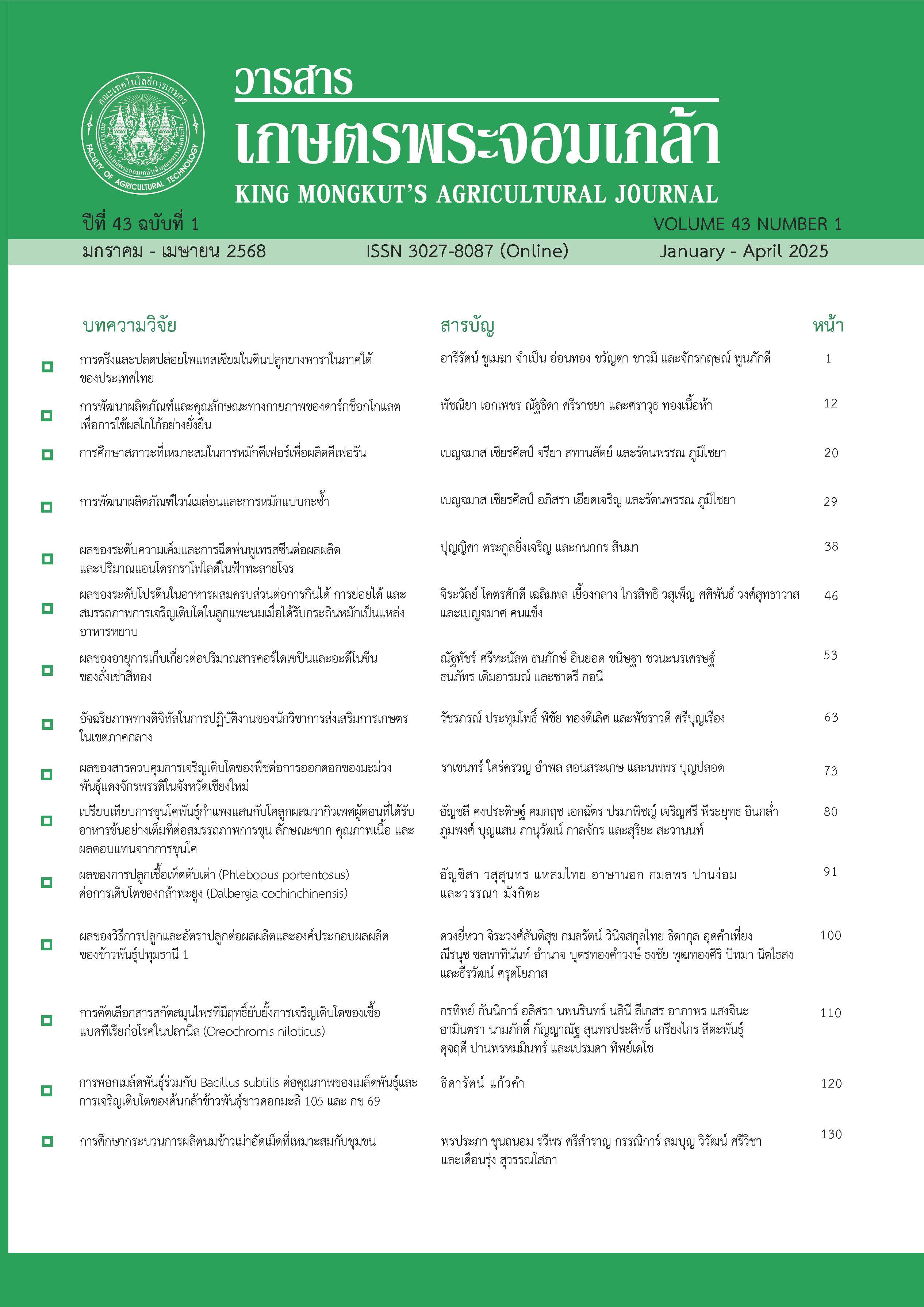เปรียบเทียบการขุนโคพันธุ์กำแพงแสนกับโคลูกผสมวากิวเพศผู้ตอนที่ได้รับอาหารข้นอย่างเต็มที่ ต่อสมรรถภาพการขุน ลักษณะซาก คุณภาพเนื้อ และผลตอบแทนจากการขุนโค
Main Article Content
บทคัดย่อ
สายพันธุ์โคเนื้อและการให้อาหารข้นที่เหมาะสมมีส่วนสำคัญอย่างมากต่อความสำเร็จในการผลิตเนื้อโคขุนคุณภาพ การศึกษานี้มีวัตถุประสงค์เพื่อเปรียบเทียบการขุนโคพันธุ์กำแพงแสนและโคลูกผสมวากิว (F1 และ F2) เพศผู้ตอนที่ได้รับอาหารข้นอย่างเต็มที่ต่อสมรรถภาพการขุน ลักษณะซาก คุณภาพเนื้อ และผลตอบแทนจากการเลี้ยงโคขุน โดยใช้โคพันธุ์กำแพงแสน และโคลูกผสมวากิว (F1 และ F2) กลุ่มละ 8 ตัว (น้ำหนักเฉลี่ย 406.04 กก. และอายุเฉลี่ย 18 เดือน) วางแผนการทดลองแบบสุ่มสมบูรณ์ โคได้รับอาหารข้นสูตรทางการค้าและหญ้าเนเปียร์หมักอย่างเต็มที่ และเสริมฟางข้าว 1 กก./ตัว/วัน ทำการเลี้ยงโคขุนเป็นเวลา 368 วัน นำข้อมูลที่ได้มาวิเคราะห์ความแปรปรวนร่วม โดยใช้น้ำหนักเริ่มต้นเป็นตัวแปรร่วม เปรียบเทียบความแตกต่างระหว่างกลุ่มทดลอง ด้วยวิธี Tukey's Honesty Significant Difference (HSD) และทำการเปรียบเทียบความแตกต่างของค่าเฉลี่ยของต้นทุน รายได้ และผลตอบแทนจากการเลี้ยงโคขุนระหว่างสองสายพันธุ์ ผลการศึกษาพบว่าโคพันธุ์กำแพงแสน และโคลูกผสมวากิว (F2 และ F1) มีสมรรถภาพการขุน ลักษณะซาก และคุณภาพเนื้อไม่มีความแตกต่างกัน (P>0.05) แต่โคลูกผสมวากิว F1 มีเปอร์เซ็นต์ซากต่ำกว่าโคลูกผสมวากิว F2 ในขณะที่โคลูกผสมวากิว F1 มีแนวโน้มที่จะมีการสะสมไขมันแทรกในมัดกล้ามเนื้อสันนอกสูงกว่า (P=0.09) โคลูกผสมวากิว F2 หรือโคพันธุ์กำแพงแสน อย่างไรก็ตามในการทดลองนี้การเลี้ยงโคขุนโดยให้อาหารข้นอย่างเต็มที่ยังไม่มีความเป็นไปได้ในการลงทุน
Article Details

อนุญาตภายใต้เงื่อนไข Creative Commons Attribution-NonCommercial-NoDerivatives 4.0 International License.
วารสารเกษตรพระจอมเกล้า
เอกสารอ้างอิง
AOAC International. (2016). Official Methods of Analysis of Association of Official Analysis Chemists. 20th Ed. Rockville.
AOAC International. (2019). Official Methods of Analysis Association of Official Analysis Chemists. 21st Ed. Rockville.
Boonsaen, P., Winn Soe, N., Maitreejet, W., Majarune, S., Reungprim T., & Sawanon, S. (2017). Effects of protein levels and energy sources in total mixed ration on feedlot performance and carcass quality of Kamphaeng Saen steers. Agriculture and Natural Resources, 51(1), 57-61.
Cafferky, J., Hamill, R. M., Allen, P., O’Doherty, J. V., Cromie, A., & Sweeney, T. (2019). Effect of breed and gender on meat quality of M. longissimus thoracis et lumborum muscle from crossbred beef bulls and steers. Foods, 8(173), 1-10.
Chaiyahan, P., Sawanon, S., Boonsaen, P., Panyaboon, T., Hrianthong, N., Innuruk, P., Chompunich, W., & Poonko, S. (2009). Influences of body conformation and fat feeding value on feedlot performances and carcass qualities of crossbreed beef cattle. In proceeding of the 5th Naresuan Environmental Conference, pp. 374-385. Naresuan University. (in Thai).
Ferreira, O. G. L., Rossi, F. D., Coelho, R. A. T., Fucilini, V. F., & Bene-detti, M. (2012). Measurement of rib-eye area by the method of digital images. Revista Brasileira de Zootecnia, 41(3), 811–814.
French, P., & Moloney, A. P. (2001). A note on diet digestibility, feed conversion efficiency and growth in steers offered ad-libitum or restricted allowances of concentrates. Irish Journal of Agricultural and Food Research, 40(2), 271-275.
Honikel, K. O. (1987). How to measure the water–holding capacity of meat? Recommendation of standardized methods. In Tarrant, P. V., Eikelenboom, G., & Monin, G. (Ed.). Evaluation Control of Meat Quality in Pigs, pp. 129–142. Martinus Nijhoff.
Kahi, A. K., & Hirooka, H. (2005). Genetic and economic evaluation of Japanese Black (Wagyu) cattle breeding schemes. Journal of Animal Science, 83, 2021–2032.
Liu, X. D., Moffitt-Hemmer, N. R., Deavila, J. M., Li, A. N., Tian, Q. T., Bravo-Iniguez, A., Chen, Y. T., Zhao, L., Zhu, M. J., Neibergs, J. S., Busboom, J. R., Nelson, M. L., Tibary, A., & Du, M. (2021). Wagyu–Angus cross improves meat tenderness compared to Angus cattle but unaffected by mild protein restriction during late gestation. Animal, 15(2), 100144. http://doi.org/10.1016/j.animal.2020.100144.
Nade, T., Okumura, T., Misumi, S., & Fujita, K. (2005). Effects of feeding different levels of concentrate on growth and carcass characteristics in younger Japanese Black cattle. Animal Science Journal, 76(1), 43-49.
Namikawa, K. (2011). Breeding History of Japanese Beef Cattle and Preservation of Genetic Resources as Economic Farm. Retrieved from: https://www.ansci.wsu.edu/.../BreedingHistoryofJapaneseBeefCattle.doc.
National Bureau of Agricultural Commodity and Food Standards (ACOS). (2004). National Food and Agricultural Commodity Standards: Cattle Meat. AIS 6001-2004. Ministry of Agriculture and Cooperatives. (in Thai).
Motoyama, M., Sasaki, K., & Watanabe, A. (2016). Wagyu and the factors contributing to its beef quality: A Japanese industry overview. Meat Science, 120(1), 10–18.
Poolthajit, S., Srakaew, W., Haitook, T., Jarassaeng, C., & Wachirapakorn, C. (2022). Growth performance, blood metabolites, carcass characteristics and meat quality in finishing wagyu crossbred beef cattle receiving betaine–biotin–chromium (BBC) supplementation. Veterinary Sciences, 9(314), 1-15.
Radunz, A. E., Loerch, S. C., Lowe, G. D., Fluharty, F. L., & Zerby, H. N. (2009). Effect of Wagyu-versus Angus-sired calves on feedlot performance, carcass characteristics, and tenderness. Animal Science Journal, 87(9), 2971-2976.
R Core Team. (2022). R: A Language and Environment for Statistical Computing. R Foundation for Statistical Computing. Retrieved from: http://www.R-project.org/.
Sangthong, S. (2006). Kamphaeng Saen Beef Cattle. Kamphaeng Saen Cattle Raising Club. (in Thai).
Sawanon, S. (2013). Organic Beef Cattle Production. Kasetsart University Press. (in Thai).
Sawanon, S. (2018). Rumen Microbiology and Utilization. Staff Division Kasetsart University. (in Thai).
Sawanon, S. (2019). Unit 12 Business management for beef cattle production. In The Course Material on Business Management for Animal Production: Unit 8-15, pp. 12-1–12-41. Office of the University Press, Sukhothai Thammathirat Open University. (in Thai).
Ueda, Y., Watanabe, A., Higuchi, M., Shingu, H., Kushibiki, S., & Shinoda, M. (2007). Effect of intramuscular fat on the beef traits of Japanese Black steers (Wagyu). Meat Science, 78(1), 189-194.
Utrera, A. R., & Van Vleck, L. D. (2004). Heritability estimates for carcass traits of cattle: a review. Genetics and Molecular Research, 3(3), 380-394.


